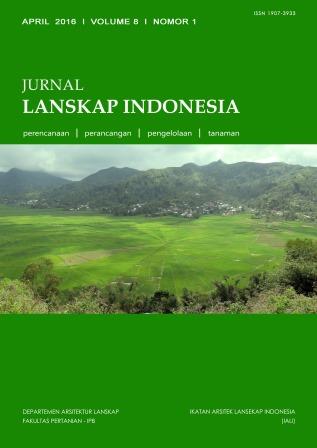MANFAAT KANOPI POHON DALAM UPAYA PENYIMPANAN DAN DAYA SERAP KARBON DI KAWASAN PERUMAHAN
Abstract
Residential development in urban areas was requiring extensive landscape changes. This development caused the decreases of urban green land. The high rate of CO2 in the atmosphere is one impact of the reduction of green land in urban area.The existing plants are unable to sequester the amount of CO2 in atmosphere. Plans especially trees are landscape elements which can reduce CO2 in the atmosphere through the photosynthesis process. With this research we can see and know how large the benefits of tree for carbon storage and sequestration in residential. This research was held in two residential that Bukit Cimanggu City and Yasmin, Tanah Sareal, Bogor. Analysis was done to spatial data using ArcView and CITYgreen5.4 extension. This report showed that the greater of trees canopy and trees number then the greater of the amount of carbon storage and sequestration. The result of this research are tabular data and spatial data with simulations examples of open green space (trees) from analysis area in each residential.
Downloads
References
American Forest. 2002. CITYgreen 5.0:User Manual. Washington DC: American Forest. 187 page.
Dahlan EN. 2007. Analisis Kebutuhan Luasan Hutan Kota sebagai Sink Gas CO2 Antropogenik dari Bahan Bakar Minyak dan Gas di Kota Bogor dengan Pendekatan Sistem Dinamik. [Disertasi]. Bogor. Program Studi Ilmu Pengetahuan Kehutanan, Sekolah Pasca Sarjana, Institut Pertanian Bogor.
McPherson EG dan Simpson JR. 1999. Carbon Dioxide Rreduction Through Urban Forestry: Guidelines for Professional and Volunteer Tree Planters. California: U.S. Department of Agriculture, Forest Service.
Purwaningsih S. 2007. Kemampuan Serapan Karbondioksida pada Tanaman Hutan Kota di Kebun Raya Bogor. [Skripsi]. Bogor. Departemen Konservasi Sumberdaya Hutan dan Ekowisata, Fakultas Kehutanan, Institut Pertanian Bogor.
Suryadi Y. 2008. Dinamika Pola Pemanfaatan Lahan dan Pengendalian Menuju Pembangunan Kota Bogor yang Berkelanjutan. [Tesis]. Program Pascasarjana, Institut Pertanian Bogor. 136 hal.
This journal permits and encourages authors to post items submitted to the journal on personal websites or institutional repositories both prior to and after publication, while providing bibliographic details that credit, if applicable, its publication in this journal. However, after the article is submitted and published in this journal, it is fully copyrighted by the Jurnal Lanskap Indonesia or JLI. If excerpts from other copyrighted works are included, the author must obtain written permission from the copyright owner and give credit to the source in the article. Then, the writer or reader is allowed to copy, share, and redistribute articles/material in any form. But it must still include the appropriate source and credit because the article in this journal is licensed by Creative Commons Attribution 4.0 International License (CC BY 4.0).
I. Proposed Policy for Journals That Offer Open Access
Authors who publish with this journal agree to the following terms:
- Authors retain copyright and grant the journal right of first publication with the work simultaneously licensed under a Creative Commons Attribution License that allows others to share the work with an acknowledgement of the work's authorship and initial publication in this journal.
- Authors are able to enter into separate, additional contractual arrangements for the non-exclusive distribution of the journal's published version of the work (e.g., post it to an institutional repository or publish it in a book), with an acknowledgement of its initial publication in this journal.
- Authors are permitted and encouraged to post their work online (e.g., in institutional repositories or on their website) prior to and during the submission process, as it can lead to productive exchanges, as well as earlier and greater citation of published work (See The Effect of Open Access).
II. Proposed Policy for Journals That Offer Delayed Open Access
Authors who publish with this journal agree to the following terms:
- Authors retain copyright and grant the journal right of first publication, with the work after publication simultaneously licensed under a Creative Commons Attribution License that allows others to share the work with an acknowledgement of the work's authorship and initial publication in this journal.
- Authors are able to enter into separate, additional contractual arrangements for the non-exclusive distribution of the journal's published version of the work (e.g., post it to an institutional repository or publish it in a book), with an acknowledgement of its initial publication in this journal.
- Authors are permitted and encouraged to post their work online (e.g., in institutional repositories or on their website) prior to and during the submission process, as it can lead to productive exchanges, as well as earlier and greater citation of published work (See The Effect of Open Access).



























